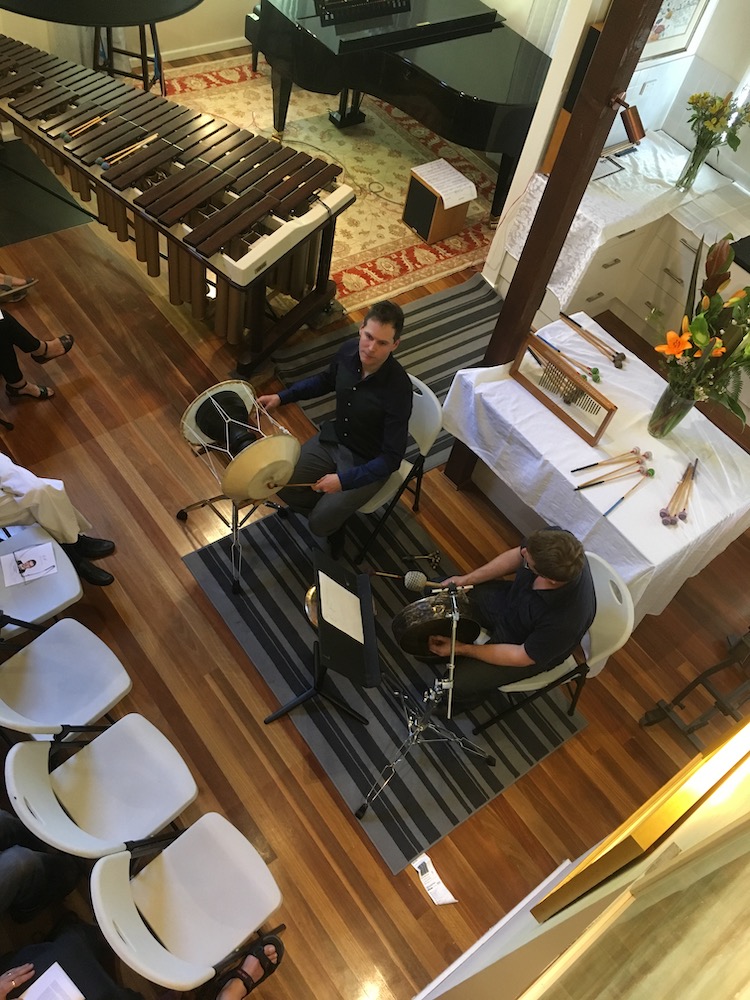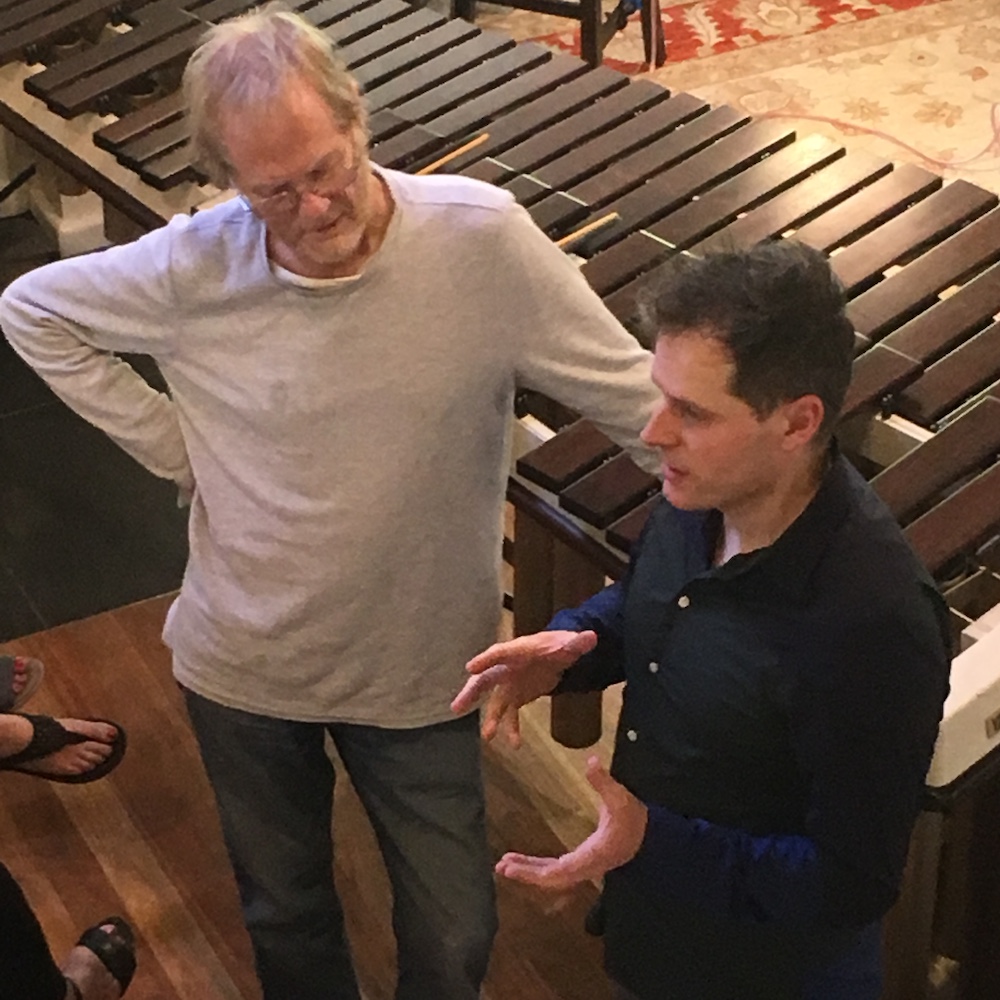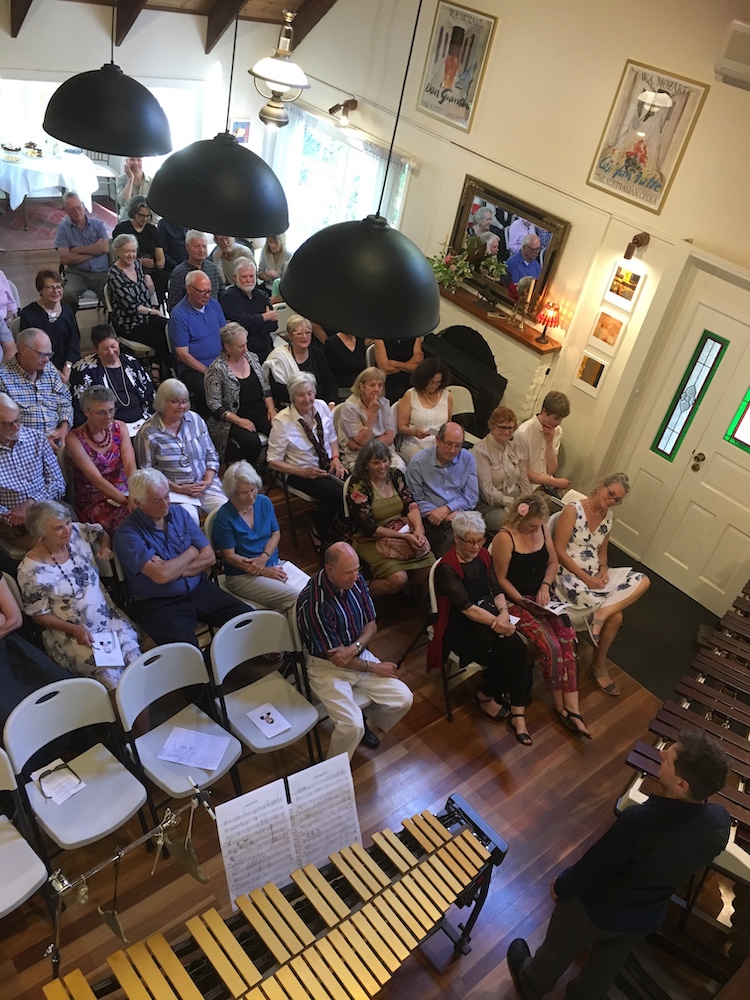Serenata, Kangaroo Valley
November 11, 2018
Like many country towns throughout this country, the tiny hamlet of Kangaroo Valley has become a hive of cultural and creative activity. As disaffected city-dwellers seek havens for their twilight years, towns like ‘The Valley” have become a beacon for arts people. When one arrives, others visit and find themselves looking at real estate. Within a few years, evenings of choral singing and chamber music become weekend concerts and, gradually, events, concert series and festivals.
Such is the case with Kangaroo Valley, nestling quietly in the Southern Highlands, about an hour between Mittagong and Nowra, and a couple of hours’ drive from Sydney or Canberra. It takes barely an hour before its village life and lush pastures spin their calming magic – think of the movie Babe which was filmed around the area – and people begin to think about their crippling city mortgages.
 Timothy Constable and Tim Brigden. Photo © Vincent Plush
Timothy Constable and Tim Brigden. Photo © Vincent Plush
Two decades ago, Belinda Webster, the genial founder of the trail-blazing Tall Poppies record label, was probably the first arts-person to arrive. Around the same time, writer and law academic Peter Wesley-Smith bought a property at the far end of the Valley, and was joined by his twin brother, Martin, the much loved composer and a pioneer of computer music in this country. Before long, Andrew Ford and Anni Heino had moved into nearby Robertson, as had conductor-composer-pianist David Stanhope. Scattered throughout and close by The Valley are other names well-known in the arts, among them opera singer Lorina Gore, rock star Peter Garrett, ABC announcer Peter Thompson and actors Jillian O’Dowd, Judy Davis and Colin Friels, and Gary McDonald, as well as noted Grainger scholar Jane McKellar.
Among the latest arrivals is the pianist and composer Robert Constable, well-known as a leading figure in music academic circles in Sydney, Newcastle, Auckland and Christchurch.
In late 2012, Robert bought a five-acre property a few kilometres out of town and saw the large house, built in 1989, as a home for the 6.5 feet Bosendorfer grand piano he had acquired in Auckland. He christened the property “Serenata” after the extraordinary dawn chorus of birds around his property. It wasn’t long before the ‘Serenata Concert Series’ was born, largely at the suggestion of Robert’s partner, Jane McKellar. (Let’s hope we see lots of Grainger in future events in The Valley. Old Percy would been chuffed!)
Beginning in August this year, the series has presented Sunday afternoon concerts by the Streeton Trio, a piano recital by Piers Lane and a duo-recital by Lane and English violinist Tasmin Little.
This past Sunday afternoon, the final concert of this initial series featured the percussionist Timothy Constable, with associate artists Tim Brigden, another percussionist, and his proud dad, Robert Constable, as composer-pianist.
 Martin Wesley-Smith and Timothy Constable. Photo © Vincent Plush
Martin Wesley-Smith and Timothy Constable. Photo © Vincent Plush
Now 40 years of age, Timothy Constable is a treasured favourite of audiences and his many collaborators. Greatly admired and liked, he has had an illustrious career as a permanent player with the Sydney Symphony Orchestra and as Artistic Director of Synergy Percussion (2009-2014), as well as in extensive collaborations with ensembles such as Sydney’s TaikOz and the South Korean ensemble Noreum Machi. He has also set about extending the repertoire for solo percussion by exploring music from other cultures and eras. Among many such projects, he has transcribed J.S.Bach’s Sonatas and Partitas for solo violin, performing all six at the Australian Festival of Chamber Music in Townsville over several years.
In Kangaroo Valley last Sunday, Timothy Constable launched his recital with his transcription of the Sonata in C Major for Unaccompanied Violin, BWV 1005 (1720), possibly the least played and least favoured by violinists (due to its awkward key of C).
The opening Adagio movement lowered the audience cautiously into an intensely attentive frame of mind, Constable almost teasing individual fragments and individual pitches from his six-octave Yamaha marimba. For the ensuing Fuga, Constable moved to his four-octave vibraphone. At around 12 minutes, this is one of the most extended and complex fugues Bach ever wrote, and the clarity of individual voices is paramount. To these ears, the metallic sheen of the vibraphone may not have helped unravel Bach’s dense counterpoint, but the ensuing two movements, the Largo and the closing Allegro assai, were breath-taking in their clarity and delivery.
For a suite of ritual music from the Kiongi province on the south-east coast of South Korea, Constable brandished an hour-glass drum and was joined by fellow percussionist Tim Brigden who beat snatches of rhythms on a small gong. At seven minutes, this item, Kiongi Dodang Kut, was just long enough to present the bare outlines of this ancient shamanic ritual music, but the audience was loud in it appreciation of its complex and unfamiliar rhythms and Constable’s vocal declamations.
 Timothy Constable and the Serenata Series audience. Photo © Vincent Plush
Timothy Constable and the Serenata Series audience. Photo © Vincent Plush
A wave of warmth, even love enveloped the audience for a performance of For Marimba and Tape, one of the best known and often performed pieces by Martin Wesley-Smith, longtime resident in The Valley. Originally created for the American clarinettist F.Gerard Errante, with tape accompaniment derived on the Fairlight CMI (Computer Music Instrument) at the Sydney Conservatorium, the composer re-worked the piece for percussionist Graeme Leak for the American tour by the contemporary music group Flederman in January 1983. Over its long life of 35 years and international span, For Marimba and Tape is surely one of the staples of the international percussion repertoire.
Timothy Constable first played this 12-minute piece when he was 13. He has grown with it over the decades and delivers it, from memory, with authority and panache, tossing off its witty slides and asides, its subtle unisons and ejaculatory explosions in a virtuoso manner that draws attention to the music, as much as the performer. A rare quality in any performer.
Introduced by the ailing composer, who was accompanied by his two brothers and extended family, there was something of a heart-felt silent ovation from the audience. At the outset of the program, Robert Constable described the event as “a family affair”, not only drawing the obvious father-son association, but also the “family” of colleagues and composers at the Sydney Conservatorium in the 1970s (Wesley-Smith, Ross Edwards, myself and Constable and, of course, the late Richard Gill, amongst others). He also reflected on the palpable ‘family’ spirit of the audience, most of the 80 or so were locals who were intensely supportive of the Serenata enterprise.
After an extended intermission in the gardens, the two Tims played a short work by Constable fils called Last Waltz (2012) on two small batteries set up on the landing. Filing back inside, the audience heard a 13-minute piece by Constable père, a work called Stargazer. This began life as a piano duet in 2015 and this year was re-coloured with the addition of vibraphone and metal percussion. A response to the time-lapse high-sky photography of New Zealander Fraser Gunn, the work had a strong religious undertow. The call-and-response between piano keyboard and metal instruments recalled elements of the music of George Crumb – as a pianist, Constable was an early exponent of Crumb’s music in this country – and the audience sat in rapt wonderment, barely moving through an unfamiliar and serene landscape that was very different to the joyous clangour of much of the other works on the program.
Stargazer’s musings were soon dispelled by the last scheduled work on the program, an eight-minute piece called Marimba Spiritual (1983) one of the best-known pieces by the Japanese composer Minoru Miki (1930-2011). Played by both percussionists on marimba and unpitched drums, it unleashed a lot of energy and noise – to no great effect, I thought – but it clearly made its mark with the audience who insisted on an encore. This emerged as a largely improvised piece based on African rhythms and banjo music of the American South. In another context, this reflection of the ‘Atlantic Crossing’ of the slave trade, particularly between Sierra Leone and Charleston, South Carolina, merits more extensive treatment.
Robert Constable has recently become Artistic Director of the Kangaroo Valley Music Festival, which will be held over three days next autumn, a time when The Valley will surely be at its most resplendent best, from Friday May 3 to Sunday May 5; this creates an unfortunate but unavoidable clash with the Canberra International Music Festival, which runs from May 2 – 12. The Valley’s music events run parallel with its much acclaimed Sculpture Festival which opens on Thursday May 2. The second series of Serenata concerts will commence in September, with a handful of concerts scheduled over the spring months.
This modest series of concerts in Kangaroo Valley stands as a incandescent example of what can be done when local people band together to bring fine music into their homes and out into their community. Without a designated arts centre or appropriate venue, this is a more modest enterprise than the likes of Huntington, the festivals in Margaret River and on the Victorian wine fields.
In terms of community response and interaction with professional musicians, though, these Serenata concerts are not only a delight to experience but also represent an essential home-grown component of our soul and well-being.











Comments
Log in to join the conversation.